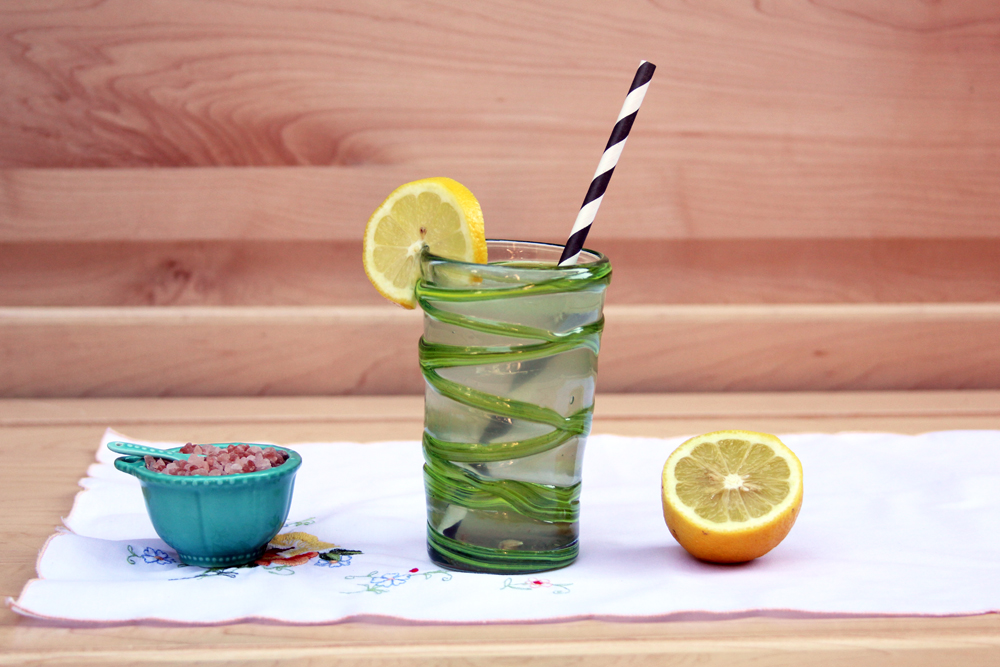
It is terrible to get the pukes in the middle of the night when you’re a first time mom with a 13 month old baby. You wake up to your baby crying. You trudge to your baby’s bedroom, and as soon as you pick her up, she pukes all over you. On your rush to get her to the bathroom, you start vomiting in the hallway.
Then your husband wakes up just in time to see you slip on the puke and land on your butt. Now you are covered in puke while holding a baby also covered in puke, sitting in a puddle of puke. At this point, you just have to laugh.
And we did. This really happened.
Afterwards, we all recovered with Salty Lemonade, including my 13 month old daughter. I’m not a big fan of Pedialyte, although if you have to use that in a pinch, I won’t hate you for it. Pedialyte contains artificial flavors, artificial sweeteners, and food dye. Just what you need when you’re sick! More chemicals!
I recommend Salty Lemonade to patients when they have any form of gastroenteritis that presents with vomiting or diarrhea and there’s a risk for dehydration. Excessive vomiting or diarrhea can dehydrate you and throw off your electrolytes. In extreme cases, rehydration IV therapy is needed rather than oral rehydration therapy. However, most moderate cases of dehydration can resolve with oral rehydration therapy alone.1
I like to use lemons for my homemade electrolyte replacement drink because they are low in sugar. I’ve seen some electrolyte replenishing recipes use freshly squeezed orange juice, but I don’t think that’s the best idea. It’s too high in sugar. Pouring orange juice down the hatch when your body hasn’t had anything to eat for 24 hours will create an unnecessary spike in your blood sugar, which can result in hypoglycemia 2-3 hours after you’ve had the drink. You want an electrolyte drink low in sugar so that your blood sugar stays stable. I sweeten Salty Lemonade with liquid stevia, which does not bother the blood sugar. You don’t want to fix one problem while giving yourself another, right?
Making a homemade electrolyte replacement drink will obviously result in different numbers when compared to store bought Pedialyte. Because I like to compare, I made a graph for you to see the difference below. I obtained nutrient information for the lemon juice and the Pedialyte from the USDA Nutrient Database. Because the USDA Nutrient Database did not have information on special non-iodized salt, I used the nutrient information for real salt, found on the real salt website. Calculations are from 1/4 tsp of real salt. I was fascinated to find that regular ole Pedialyte does not provide any vitamins, but that’s actually a good thing! Most companies dump stupid folic acid in their products, and we don’t need anymore of that. Salty Lemonade has a tiny bit of folate and vitamin C (folate found in nature is A-OK)!
| Salty Lemonade | Pedialyte | |
|---|---|---|
| 1.5 Cup Comparison | ||
| Sodium | 530mg | 378mg |
| Chloride | 840mg | 441mg |
| Potassium | 50mg | 288mg |
| Magnesium | 4.28mg | 3mg |
| Calcium | 10mg | 37.5mg |
| Zinc | 1mg | 0.08mg |
| Iron | 0.8mg | 0mg |
| Phosphorus | 93mg | 37.5mg |
| Folate | 10mg | 0mg |
| Vitamin C | 18.6mg | 0mg |
| Sugar | 1.2g | 9.2g |

Lastly, I must talk about salt because I spent about 4 hours on a bunny trail researching it when I was supposed to be writing this post. I prefer natural, unprocessed salt, but there is quite the controversy on what natural salt is THE BEST salt. And, about 5 minutes ago, I heard the Wendy’s Eating Husband say, “You better not be researching that salt right now! You better be writing your post!”. So, I have to make use of my research to justify how many hours I put into learning about the Pink Himalayan Salt Mines in Pakistan. Now, I want to visit them.
The bunny trail started when I found some internet articles (not sure of their validity) claiming that pink himalayan salt is actually bad for you because it has high amounts of fluoride and bromide in it. However, in my research, I found that real salt actually had higher amounts of fluoride and bromide than the Pink Himalayan Salt.
Pink Himalayan Salt is my favorite salt for both taste and beauty. I love that it’s naturally pink (the pink color is supposedly from it’s iron content). I’m not going to worry about eating it. But just so you know, it may not be THE BEST salt for your optimal health. After all that research, I’m even more obsessed with Pink Himalayan Salt, especially after watching this fascinating video. And if you want to read about the working conditions and how they get the salt out of the mines, check out this article from the Seattle Times. Pink Himalayan Salt is what I used in the photograph.
This recipe is an eyeball it up kind of thing. No need to pull out all the measuring equipment when you’re sick.
Some people should not have salt. If your doctor has advised you to avoid salt, then please make Salty Lemonade for someone else.
Salty LemonadeIngredients
- filtered water
- juice of 1 freshly squeezed lemon
- a good pinch of natural, unprocessed salt
- 10 drops of liquid stevia
- Place lemon juice, salt, and stevia in the bottom of a large drinking glass.
- Fill the rest of the glass with filtered water.
- Stir.
- Sip the drink slowly
References
1. Spandorfer PR, Alessandrini EA, Joffe MD, et al. Oral versus intravenous rehydration of moderately dehydrated children: a randomized, controlled trial. Pediatrics. Feb 2005. 115(2):295-301.







